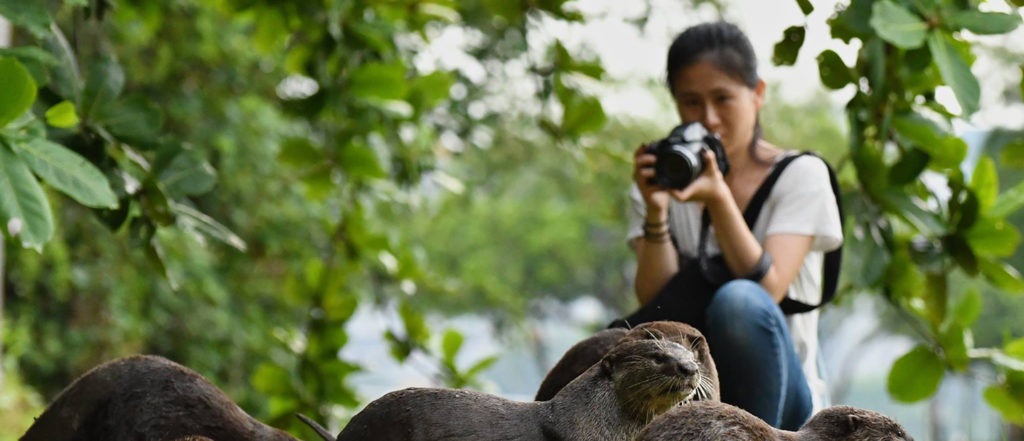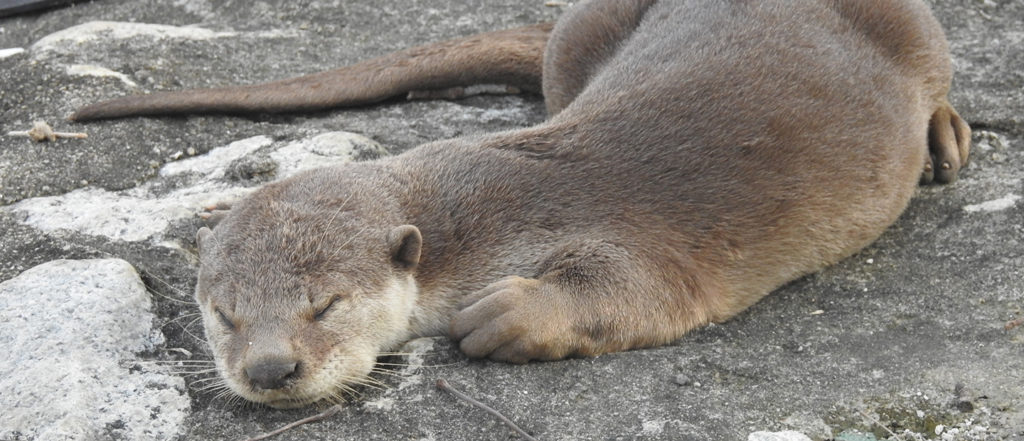Yale-NUS students conduct research on otters

Over several months, Tan Mei-Mei (Class of 2018) travelled around Singapore in search of wild otters. Once thought to be extinct, the smooth-coated otter has become increasingly common in various regions of the country.
“As part of my summer research project, I was involved in observational field work on the behaviour of the smooth-coated otter. Using a digital camera, I was out in the field every day to find, follow and collect videographic and other data on Singapore’s wild otter population,” Mei-Mei shared.
Like her, Yeo Zhi Yi (Class of 2020) also spent his summer tracking and observing otters while gathering video data for analysis. The two students were working as research assistants for an otter watching project led by Assistant Professor of Science Philip Johns.
Mei-Mei shared that she decided to join the project as she was interested in conducting research on wildlife for her final-year capstone project.
“I was keen on participating in research and eventually writing my capstone on wildlife, particularly mammalian wildlife, and a classmate suggested I get in touch with Dr Philip Johns because he was researching otters. After my first few introductory field sessions, I became so interested in studying these animals that there was no question about continuing,” she shared.
Zhi Yi was similarly interested in working with animals and wildlife in general. “I got pretty excited when I knew about the opportunity last summer. Before I started, I actually didn’t know much about otters in Singapore, but I have always been interested in the wildlife and biodiversity in Singapore,” he recounted.
Apart from collecting data about the otters, both of them also helped to analyse the collected data. For Zhi Yi, this involved going through the recordings and identifying relevant aspects for further analysis.

“I’ve been analysing all the data that we’ve collected, and then extracting the features that we’re interested in, either by logging behaviour or using software to extract spectral properties of their vocalisations for further analysis. Further analysis includes using software like R to run tests to try and find patterns from the features that we’ve noticed,” he explained.
R is a programming language for statistical computing that all Yale-NUS students would learn to utilise in the Quantitative Reasoning module, which is part of the Yale-NUS Common Curriculum.
“So far, we’ve found some preliminary evidence to suggest our hypothesis that herding (a type of fishing behaviour) is actually a form of teaching where older otters teach otter pups how to fish,” he added.
Sharing her experience working on the project, Mei-Mei said, “I love every aspect of this project, from reading up on the literature of this species to help me better understand what I am recording, to spending up to thirteen hours a day on foot and bike following the otters with a group of people in the community who are equally passionate about these animals in different ways.”
“For me, the most rewarding part of this project was having the chance to see wildlife-human interaction and conflict happening on the ground, and also how Singapore’s community – from the government to members of the public – is responding to such situations using a science-based approach,” she said.
Because of her research experience with otters, Mei-Mei has also been interviewed by the BBC and Channel NewsAsia on these animals and her involvement in otter watching.
Apart from studying wild otters, some students have also been involved in studying otters in captivity at the Singapore Zoo. One such student is Li Yuyunting (Class of 2020), who started observing the otters as part of the research project.
“I decided to join the otter watching project in the second half of my first year because I like animals and wanted to learn more about them,” she shared.
“As a research assistant, I observed the animals inside their enclosure, swimming pool and playground during day time, and took note of things that would help us design our experiments better, not only for our research purposes but also for the otters’ well-being,” she explained.
Beyond the summer research project, Mei-Mei is also studying otters for her capstone project with Dr Johns, focusing on territorial aggression within the species.
“Over the summer during my work as a research assistant, a territorial dispute occurred between two otter family groups in Marina Reservoir and along Singapore River. I realised that currently very little is known about this aspect of this species, because smooth-coated otters are extremely elusive everywhere else in the world. Previous studies on this species have been either on captive otters or based on data from camera traps, so no researcher has ever seen and recorded such wild behaviour before,” she explained.
What Mei-Mei has found most amazing from her research has been how the wild otters in Singapore “have adapted spectacularly to this country’s urban landscape”.
“In Singapore, all the otters are diurnal like humans, although previously this species was only known to be nocturnal. Furthermore, some families are actually more comfortable with and would choose man-made structures for their holts over natural environments,” she noted.
Yale-NUS students have many opportunities to take part in research projects. These include participating in the Centre for International & Professional Experience (CIPE)’s Summer Research Programme, working as research assistant for faculty, taking up research internships with external organisations, and taking Independent Reading and Research (IRR) modules where they can conduct research for course credit.





